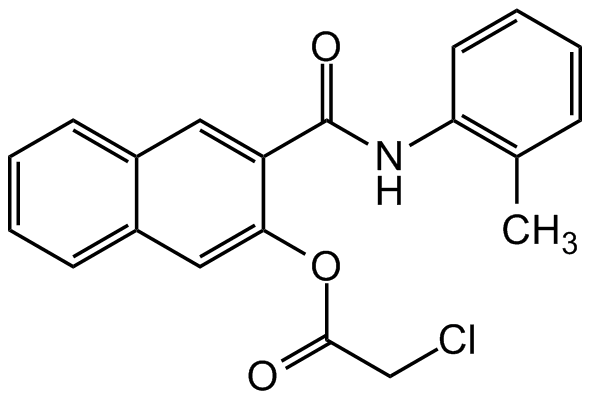
Chemical Structure
Naphthol AS-D chloroacetate
CDX-N0245
CAS Number35245-26-2
Product group Chemicals
Estimated Purity>99%
Overview
- SupplierChemodex
- Product NameNaphthol AS-D chloroacetate [35245-26-2]
- Delivery Days Customer10
- CAS Number35245-26-2
- CertificationResearch Use Only
- Estimated Purity>99%
- Scientific DescriptionChemical. CAS: 35245-26-2. Formula: C20H16ClNO3. MW: BD9837. Naphthol AS-D chloroacetate (NASDCA) is a fluorigenic substrate for granulocyte specific esterases (e.g. Proteinase 3 (PR3) and Cathepsin G). It can be hydrolyzed into Naphthol AS-D by esterases to mix with diazonium salt and form insoluble red-brown precipitate in the cytoplasm that can be visualized under a microscope. This enzyme is usually considered specific for cells of granulocytic lineage. NASDCA can be used for the visualisation of cells in formalin-fixed or paraffin-embedded tissue in a substrate solution for naphthol-AS-D-chloroacetate-esterase (CIAE) staining. Proteinase 3 (P3R) is a serine protease that is found in neutrophils and a subpopulation of monocytes. It is the most specific enzyme for NASDCA hydrolysis, and it is used in a variety of diagnostic tests to detect granulocytes. Cathepsin G is another serine protease that is found in neutrophils. It can also hydrolyze NASDCA, but it is not as specific as PR3. Human leukocyte elastase is a serine protease that is also found in neutrophils. It can hydrolyze NASDCA, but it is not as specific as PR3 or cathepsin G. It is important to note that not all granulocytes will stain positive for NASDCA. Basophils and eosinophils do not contain PR3, so they will not stain positive for NASDCA. However, neutrophils and a subpopulation of monocytes do contain PR3, so they will stain positive for NASDCA. - Naphthol AS-D chloroacetate (NASDCA) is a fluorigenic substrate for granulocyte specific esterases (e.g. Proteinase 3 (PR3) and Cathepsin G). It can be hydrolyzed into Naphthol AS-D by esterases to mix with diazonium salt and form insoluble red-brown precipitate in the cytoplasm that can be visualized under a microscope. This enzyme is usually considered specific for cells of granulocytic lineage. NASDCA can be used for the visualisation of cells in formalin-fixed or paraffin-embedded tissue in a substrate solution for naphthol-AS-D-chloroacetate-esterase (CIAE) staining. Proteinase 3 (P3R) is a serine protease that is found in neutrophils and a subpopulation of monocytes. It is the most specific enzyme for NASDCA hydrolysis, and it is used in a variety of diagnostic tests to detect granulocytes. Cathepsin G is another serine protease that is found in neutrophils. It can also hydrolyze NASDCA, but it is not as specific as PR3. Human leukocyte elastase is a serine protease that is also found in neutrophils. It can hydrolyze NASDCA, but it is not as specific as PR3 or cathepsin G. It is important to note that not all granulocytes will stain positive for NASDCA. Basophils and eosinophils do not contain PR3, so they will not stain positive for NASDCA. However, neutrophils and a subpopulation of monocytes do contain PR3, so they will stain positive for NASDCA.
- Storage Instruction-20°C,2°C to 8°C
- UNSPSC41116134
